by Editor | Jun 8, 2009 | Accomodations, Ecotourism, New Articles
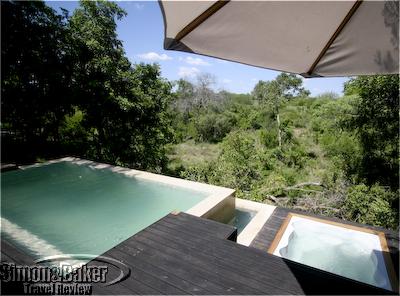
The terrace of a two-bedroom suite at The Royal Malewane
Tucked within the Thornybush Game Reserve near the town of Hoesdpruit in South Africa’s safari country there is a luxury oriented enclave favored by game viewing enthusiasts and the rich and famous. The Big Five game viewing property near http://simonandbaker.com/kruger has six luxury suites and an on site spa. There are also two independent two-bedroom suites each one the size of a small house or apartment and decorated with a personal touch by the owner.
The two bedroom suites come with a computer, well stocked kitchen with bar, plunge pool and Jacuzzi, dedicated staff as well as dining, living, and large outdoor terrace areas. Suite guests explore the game reserve at sunrise and sunset (or whenever they want) in their own safari vehicle.
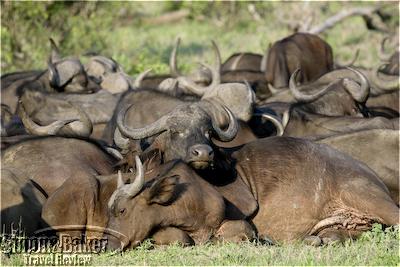
Buffalos at the Royal Malewane
The property’s most prominent feature during a recent Simon & Baker Travel Review visit was the friendly and eager to please staff. It’s no surprise since the walls of this quiet lodge have been the temporary home of many well off individuals such as an internationally famous singer who visits regularly, and the head of state of an industrial country who spent his honeymoon in one of the property’s two-bedroom suites.
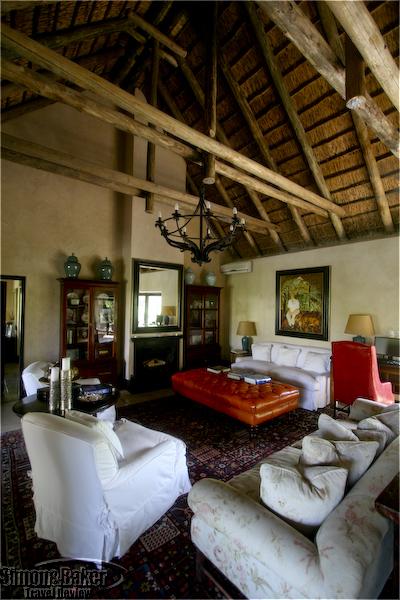
The interior of the Royal Malewane Suite
What our team liked when they visited the property was the seclusion and privacy of their stylish two-bedroom suite accommodations, gourmet cuisine, service oriented staff, and exclusive game viewing opportunities in a private vehicle with a dedicated veteran ranger and tracker team. Click here to read a dedicated article about the Royal Malewane.
by Editor | Jun 1, 2009 | Accomodations, Ecotourism, New Articles
Article and photos by Josette King
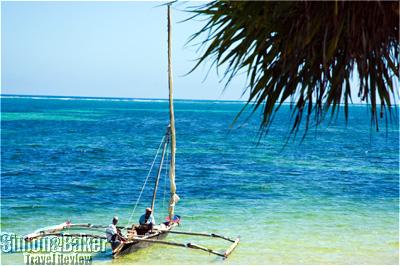
The beach at the Serena Beach Hotel and Spa in Mombasa
While I enjoy the comfort and amenities of luxury hotels, I often find them in some way at odds with my commitment to responsible tourism, which requires that “facilities invest time, money and other resources in betterment of the environment, resource use and the welfare of local communities” (per the 2002 Cape Town Declaration on Responsible Tourism). I had no such concerns on my recent visit to Kenya, where I stayed at two outstanding Serena Hotels, whose luxury accommodations met responsible tourism practices.
These properties, owned by Tourism Promotion Services Eastern Africa, Ltd (TPS, with the Aga Khan Fund for Economic Development (AKFED) the majority shareholder, had a stated policy of commitment to the local population in relation to cultural preservation, sustainable habitat and community development. The group also operated by a code of responsible practices regarding energy conservation, waste recycling, sewage disposal, air emissions, pesticides, noise reduction and visual pollution, and construction of their properties in harmony with local surroundings, using eco-friendly materials, and local handicrafts and products.
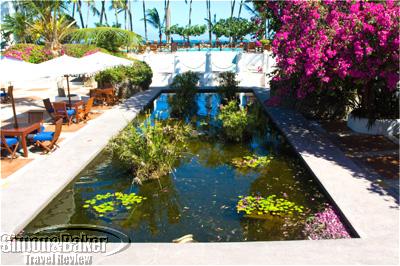
The Sokoni Pond at the Serena Beach Hotel and Spa
These principles were very much in evidence at the Serena Beach Hotel and Spa in Mombasa. Inspired by the rich architectural tradition of the East African coast, the resort was built of local material by local craftsmen into whitewashed low buildings with intricately carved deep wooden balconies overlooking courtyards shaded by blooming bougainvilleas and frangipani trees. The buildings were clustered around a central core of elegant public spaces that gave the resort the exotic appeal of an ancient Swahili town. The Village area, where my room was located, was styled to resemble the historic island town of Lamu, with its back streets winding toward the sea. My room combined the charm of local carved Lamu-style furniture, arts and crafts with the latest modern conveniences.
The atmosphere of the common areas was that of an Arabian palace, with soaring pillars, tiled fountains and Arabic furnishings and rugs. I especially liked the abundance of elegant fretwork panels throughout the property, including the Maisha Spa, said to have been made by members of the Association for the Physically Disabled of Kenya. The spa also provided an outlet for goods created by the disabled. The leather tongs used by spa guests were sourced from a local community organization that supported the disabled. These and a number of jewelry items created by the same group could be purchased at the spa reception.
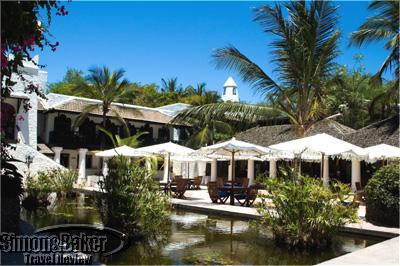
The Sokoni Nyota at the Serena Mombasa Beach Hotel
A majority of the hotel staff and visiting entertainers were drawn from the local community. Providing growth opportunities for the staff was a matter of pride within the Serena organization. I spoke to several members of the senior management team, including Charles Muia, general manager, who mentioned how some staff members had started in junior positions at Serena properties and had benefited from the company’s development program to ascend to their current positions. Muia also pointed out junior staff members presently enjoying similar opportunities at the hotel and the spa. Much of the fresh foodstuffs served in the restaurants were locally produced and procured, including the seafood that was bought from accredited local suppliers.
The Serena was graced with a seemingly endless frontage of verdant lawns and soaring palm trees overlooking a pristine creamy sand beach that was part of the Mombasa Marine National Park and Reserve, established to protect the marine and coastal environment of the Indian Ocean territorial waters. The hotel cooperated with the Kenya Sea Turtle Conservation Committee on a rescue and conservation project aimed to protect the nesting and feeding sites of seven species of migratory turtles. It also provided a secure nesting ground to protect the hatching cycle of the baby turtles.
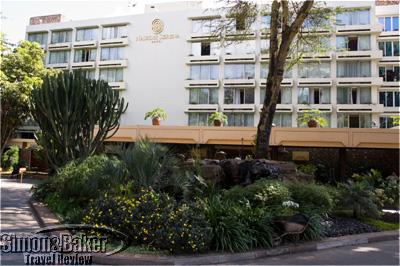
Nairobi Serena Hotel facade
While some of the least visible responsible tourism practices are hard to observe within the infrastructure of a large city hotel, the Nairobi Serena Hotel, the Serena flagship hotel in Kenya, was said to uphold the same high standards as the resort property. The six-story structure sat discretely among its own lush tropical gardens at the edge of the city’s Central Park to offer an oasis of serenity in the heart of Africa’s fourth largest city. I especially enjoyed its décor that seamlessly blended Moroccan and Swahili influences with tribal antiques and contemporary African art to create an environment of refined elegance.

Nairobi Serena Hotel sign
Several restaurants featured a variety of cuisine options, mainly from locally sourced products. Throughout the hotel the staff was efficient and polished. My room was cool and quiet, elegantly decorated in pan-African style, overlooking gardens filled with native flowering trees, and the glittering towers of the downtown Nairobi skyline beyond. Thanks to its efficient WiFi connection and satellite television with multiple international channels, it was an inviting haven to reconnect with the “modern world” after an extended safari before facing the long journey home.
Details on my visit to Kenya, and dedicated articles on the Serena Beach Hotel and Spa, Maisha Spa and the Nairobi Serena Hotel can be found on our main website at Simon and Baker Travel Review.
by Editor | May 4, 2009 | Luxury Travel, New Articles
By Elena del Valle

Love at the Mirage
Photos: Cirque du Soleil Love
During a trip to Las Vegas late last year we had an opportunity to see several shows. Our favorite was Love, a mix of Beatles music and Cirque du Soleil magic. The 90-minute performance in the 2,013-seat theater at The Mirage was a fun way to spend an evening in Sin City.
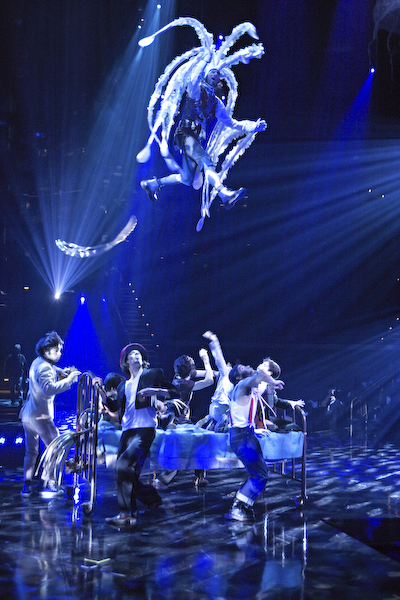
A scene from Love
Filled with some of the famous characters from The Beatles songs, featuring dozens of Cirque performers of all ages prancing in colorful and evocative costumes, accompanied by the iconic music that has circled the world over the show was wistful and lively.
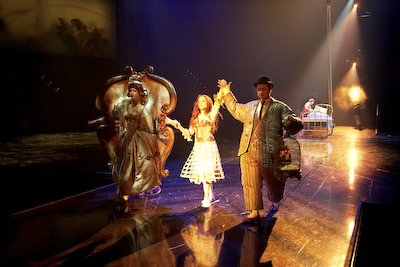
A scene from Love
In 1984, Cirque du Soleil was a group of 20 street performers; now it’s a major international organization that has provided high-quality artistic entertainment to more than 70 million spectators in close to 200 cities on five continents. In Las Vegas, Cirque du Soleil has a partnership with MGM Mirage to create and present productions. In addition to Love, visitors can try Mystère at Treasure Island, “O” at Bellagio, Zumanity, the Sensual Side of Cirque du Soleil, at New York-New York Hotel and Casino, KÀ at MGM Grand, and Criss Angel Believe at Luxor. Click here for an article about Love.
by Editor | Apr 27, 2009 | Accomodations, Ecotourism, New Articles
Article and photos by Josette King
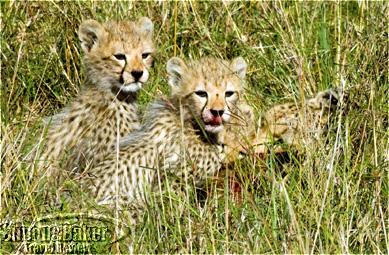
Cheetah cubs at Porini Lion Camp
I was recently in Kenya, where Gamewatchers Safaris combined superb game-watching opportunities in some of the most sought-after parks of East Africa with exemplary responsible tourism practices to deliver an outstanding safari experience.
Kenya is a country whose very name has long been synonymous with safari for seasoned and armchair travelers alike. An early leader in the preservation of game and its natural habitat, Kenya boasts more than 50 national parks and game reserves as well as private conservancies covering over 10 percent of its total landmass. The Big Five (lion, leopard, elephant, rhinoceros and buffalo) can all be found there, as well as cheetah, zebra, wildebeest, giraffe and many other carnivores and herbivores, large and small; and herds of minivans filled with awed tourists.
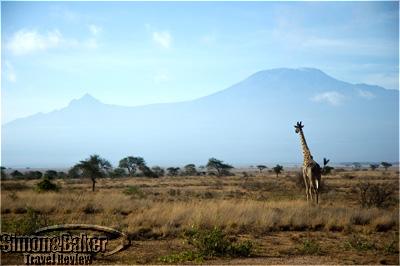
A view of Kilimanjaro from Porini Amboseli
A large number of visitors is drawn to Kenya by visions of abundant game roaming across endless open spaces punctuated by the wide umbrellas of flat-topped acacias, and proud Masai in crimson robes herding their cattle in the distance. To accommodate these visitors, the country has developed one of Africa’s most advanced tourism infrastructures, including large-scale accommodations, making it a favorite destination for group tourism. But as Kenya’s popularity as a safari destination increased, so did the potential threat to its environment. Gamewatchers Safaris has been at the forefront of addressing the challenge of enhancing the tourism experience while giving landowners a chance to improve their quality of life in the present, and preserve land and wildlife for the next generations.
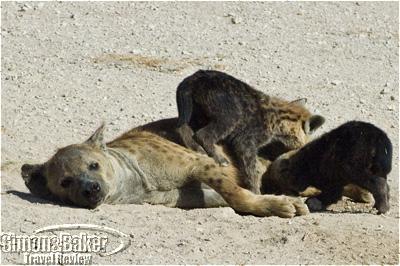
Hyenas at Porini Amboseli
With its four Porini Camps (Amboselli Porini, Porini Rhino, Mara Porini and Porini Lion) Gamewatchers Safaris offered an innovative solution: small tented camps (between six and ten tents depending on the camp) on private conservancies located in close proximity to the famed Amboseli and Masai Mara National Parks; with the exception of Porini Rhino Camp, which was in the heart of one of the largest rhinoceros sanctuaries in East Africa, in the shadow of Mount Kenya. In these rigorously eco-friendly camps, great efforts were made to minimize the impact of the properties on the environment. No permanent structures were erected, power was exclusively solar generated, and all waste was managed according to strict procedures.

A Masaai woman and child at a Porini property
The host conservancies were on private land leased from the local Masai tribes who received financial benefits and employment opportunities as well as infrastructure development (such as roads and improved access to water). Local tribesmen had access to training in various aspects of the tourism industry and employment at the camps. As the time of my visit close to 90 percent of the camps’ staff came from local tribes. Because of this close partnership, we, as camp guests enjoyed extensive contact with the local community, such nature walks with Masai Warriors, visits to the local villages where we were welcomed and allowed to observe the tasks of daily lives as well as celebration songs and dances. We were also able to enjoy nighttime game drives (these, like the walking safaris were not allowed in the National Parks). I especially enjoyed the opportunity for substantive conversations with my Masai guides about their tribes’ history, current lives and aspirations.

A baby giraffe feeding at Porini Lion Camp
Each camp was located in a spectacular site with its own game watching particularities. Click on the name of the camp to read about my memorable safari experience at each one of the Porini camps:
Amboselli Porini Camp was in the Selenkay Conservancy, adjacent to the north side of the Amboselli National Park, famous for the large herds of elephants roaming its sun-baked plains. Access to the park was via the conservancy’s private road, against the eye-popping backdrop of Mount Kilimanjaro.
Porini Rhino Camp was located on the verdant plateau of the Ol Pejeta Conservancy, between the foothills of the Aberdares Range and the stately snow-capped peak of Mount Kenya. In addition to its large rhino population, it featured large herds of rarely seen herbivores such as reticulated giraffes and Grevy’s zebras.
Mara Porini Camp was nestled in a soaring grove of yellow-barked acacia, within the Ol Kinyei Conservancy, ten miles away from the Northeast boundary of the Masai Mara National Reserve. The conservancy was host to a large resident pride of lions that I had the pleasure to observe repeatedly. Early morning game drives on my way to the park in the rolling meadows filled with herbivores browsing for their breakfast in the clear morning air were a special treat.
Porini Lion Camp was in the Olare Orok Conservancy on the northern border of the Masai Mara National Reserve. The abundance of “big cats” in the conservancy and this area of the park was such that it was hard to keep focused on any other game! Although the sight a pair of black rhinos engaged in courtship ritual did hold my attention, as did a breeding herd of elephants with several newborn calves; successfully tracking an elusive leopard was a high point of the visit, so was a pride of lions getting ready for their hunt. In the end the antics of a cheetah and her three tiny cubs won my cuteness award for the stay.
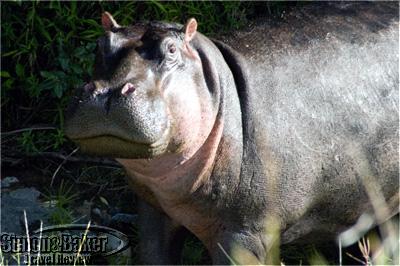
A hippo at Porini Lion Camp
Another feature that further enhanced my game-watching experience was that all game drives took place in custom-built, open-sided Land Rovers, each with three tiers of two individual seats. Although the vehicles could accommodate up to six guests, there were never more than four of us in any vehicle, and more than once I had the pleasure of a private game drive. One slight drawback: it was sometimes a challenge to repress the urge to gloat a tiny bit as I met covetous glances coming from the air-conditioned minivans I occasionally passed in the parks.
N.B. Shortly after my visit, Porini Safari Camps and its parent company Gamewatchers Safaris were honored with the Responsible Tourism Award for “Best for Conservation of Endangered Species outside Protected Area” at the 2008 World Travel Market in London. The award, sponsored by Virgin Holidays, recognized Porini/Gamewatchers “for demonstrating that a high revenue, low impact tourism development approach can benefit the local Masai through developing conservancies and tourism in partnership with safari companies to create employment and community income and to conserve their land for wildlife.”
by Editor | Feb 16, 2009 | Accomodations, Ecotourism, New Articles
Article and video by Elena del Valle, photos and video editing by Gary Cox
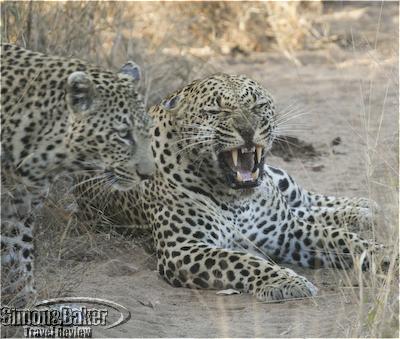
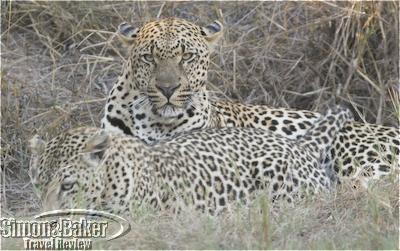
Leopards at Londolozi
Our Tree Camp experience at Londolozi was outstanding. The boutique lodge, set in a prime area of the famous Sabi Sand Reserve next to South Africa’s http://simonandbaker.com/kruger, offered luxury accommodations in a lush bush setting. We thoroughly enjoyed the gourmet fare including a surprise tasting menu with wine pairings, boma dinner with staff dancing and singing, the handsome and spacious suite with private plunge pool, and creature comforts.
“You’re coming to Londolozi because you’ll have one of the best animal viewing experiences in South Africa and you’re going to be with a ranger who has a huge amount of knowledge which he will unfold for you,” said Duncan MacLarty, camp manager, Londolozi Tree Camp. “On the Tree Camp side you will have an experience which is very personalized.”
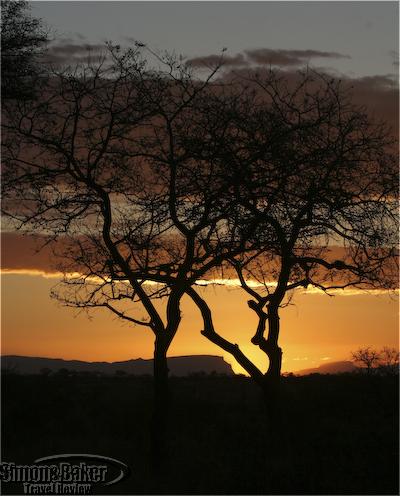
Sunset at Londolozi
We found that Duncan’s game viewing promise was fulfilled. Over the years, prior to our stay at Londolozi we stayed at dozens of bush properties in multiple African countries and had many, many outstanding game viewing experiences. In spite of that, our four-night stay at Londolozi Tree Camp stands out for the extraordinary game viewing we enjoyed.
It wasn’t just that we saw animals, including the Big Five and wild dogs. It was the quality of the game drives and sightings that stood out. Also, our guides were knowledgeable and enthusiastic about the bush, making our game viewing special.
Leopards are solitary animals, infrequently seen in groups or pairs. On our last morning we encountered mating leopards relaxed enough to allow our company. We spent six hours following, viewing and photographing the amorous couple. Click here to read a dedicated feature about Londolozi Tree Camp.
Click on the play button below to view video of some game we encountered at Tree Camp in the Londolozi Reserve.
by Editor | Feb 2, 2009 | New Articles, Restaurants and Food
Article and photos by Josette King
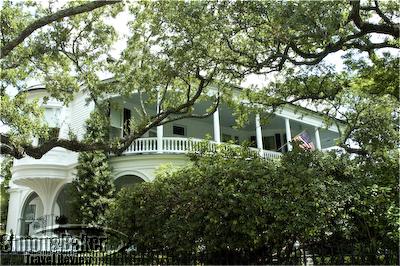
Low Country Mansion
On a recent visit to the Low Country, the coastal plain where South Carolina melts into the Atlantic Ocean, I enjoyed a few days in Charleston, the historic, cultural and culinary crown jewel of the area. There, I had the pleasure of dining at Circa 1886 where I was able to observe first hand the artistry of Marc Collins, the restaurant’s executive chef.
Tucked away in the back garden of the Wentworth Mansion, in a low pink brick building that was once its carriage house (and named for the year the mansion was built), the restaurant could be easy to miss among the grand southern mansions of its historic residential neighborhood. But although only a discrete sign at the entrance of its vine-covered trellised walk announced its presence, the word had obviously gotten around. Even on a Tuesday night in the middle of summer, the quietly formal dining room was filled with local patrons as well as Mansion guests.
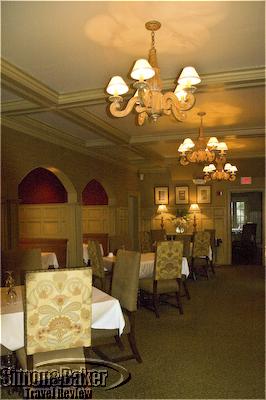
Circa 1886 dining room
The beautifully restored 19th century carriage house was an harmonious blend of original elements (such as the stable doors and heart-of-pine floors) and seamlessly integrated reconstruction features like elegant vaulted booths, boxed ceilings and flattering lighting. The timeless elegance of the décor was an appropriate metaphor for the style of Chef Collins who wove together elements of traditional southern cuisine and modern French gastronomy into an imaginative menu of understated sophistication.

Marc Collins, executive chef, Circa 1886
Chef Collins took over as executive chef of newly opened Circa 1886 in 2001 and quickly made his mark on the Charleston cuisine scene. After being singled out as chef to watch by Esquire Magazine in 2001, he went on to lead Circa 1886 to its current status as a AAA Four Diamonds and Mobile Four Stars recipient. His creations emphasized an intriguing modern approach to traditional southern cuisine, based on seasonally available local products, as well as sustainable and rebounded local fish and seafood. He found inspiration in antique cookbooks of the Low Country, where classic French and English cuisine were enhanced with vibrant Caribbean and African accents, as departure points for some of his signature dishes, such as crab cake souffle (made with mango puree) and his spicy grilled shrimp over fried green tomatoes with chow-chow.
On the night of my visit, I especially enjoyed the seared fresh foie gras first course. It was served on a glaze of Myer’s rum and garnished with bittersweet chocolate bread topped with banana gelato for an intriguing balance of tangy sweetness. My Key Lime Scallops main course was another unexpected combination: three giant seared scallops, each served on a small basil-corn flapjack, and topped with pureed buttered carrots, heart of palms and spring peas respectively; a light but satisfying dish that let the delicate freshness of the scallops shine.
The staff was polished, well informed of the particularities the menu and offerings on the wine list. The service, discretely attentive, well timed and friendly, was flawless. Click here for more about my superb dining experience at Circa 1886.






























